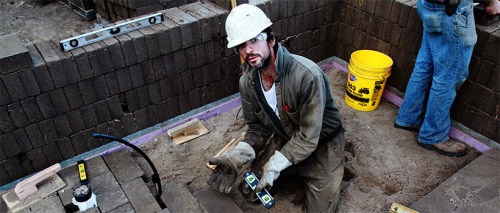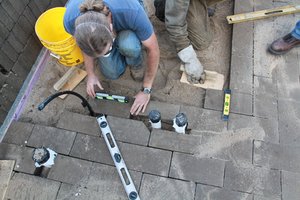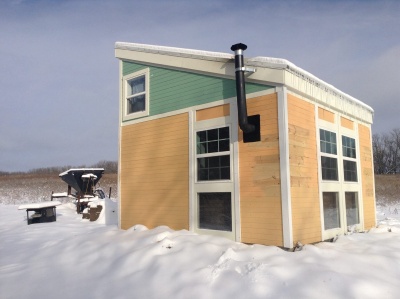CEB Floor
Seed Eco-Home 2016
Notes:
- Use masonry sand with cement to seal the cracks
- Use stone sealer at the end for a shiny surface
- Stabilized block is recommended in moist climates
- Shine and durability of surface depends on how much you want to pay for the sealer. Epoxy sealer can provide a durable, waterproof, cleanable, shiny seal. Use clear Epoxy Sealer to get a natural-looking finish
Microhouse 1 - Summer 2013
For the CEB floor, a layer of sand is used to keep all the block level. A team of 2 can do 144 square foot floor in less than a day.
Keep it flat using a level, and keep working the sand to provide height adjustment to CEBs if CEBs are not equal in height. Height of CEBs may vary depending on soil conditions when unconditioned soil without cement is used:
Final structure with CEB floor.
In Microhouse 1, we used unstabilized CEBs. We had a couple of water leaks and the CEB floor degraded, so we retrofitted a wood floor. In the humid Missouri climate, we have seen mold issues because Microhouse 1 was not air conditioned.
Links
- Jim Hallock - and Basket Technique
Source and Ergonomics
See prior art and instructionals for a floor installed ~2008 at http://velacreations.com/howto/ceb-floors/ - from which OSE got the initial knowhow. According to Abe Connally of Velacreations regarding the floor he build: Our floor was about 130 square feet. If you have the area prepped and the bricks ready, 2 people could do that size in close in less than 3 hours. You spend the most time leveling, so a key to making it go fast is to have consistent brick size/shape and a firm and level subfloor (we used sand bed).
Complete procedure from Make:


